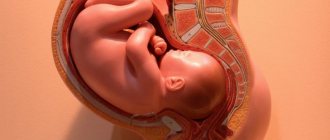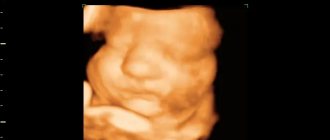During the entire period of pregnancy, the human embryo undergoes multiple changes and, as a result, from two fused cells of the parents in 9 months it becomes a full-fledged representative of humanity. Every day, every week, the fetal body increases in weight and height.
The science of embryology deals with the processes of formation and development of the fetus after conception and before birth. The obstetric gestational age begins counting from the last menstrual period of the parent. The embryonic period is counted from the moment of fertilization.
Embryo development before IVF
With artificial conception, the gestational age is calculated not from the day of fertilization, but from the moment the IVF embryo is implanted into the uterus.
However, by the time of implantation, the embryo exists and develops for 8 days. Scientists have long studied how an IVF embryo is formed, and even took pictures of the development of the embryo on each day. For about a week of IVF, the embryo grows “in vitro”. During this period, doctors assess its viability and identify developmental abnormalities. After all, in order for pregnancy to occur, the embryo must form correctly. Actually, fertilization takes place only if the embryo has developed correctly for 8 days spent in the laboratory, without deviations. If the “wrong” embryo is formed, conception will not occur. What happens to an IVF embryo in the first days after fertilization? In the table you can see how and on what day the embryo develops.
| Day | State of the embryo |
| 0 (zero) | Doctors perform direct fertilization |
| 1 | Experts assess the presence of female and male nuclei |
| 2 | Experts evaluate the quality of the embryo by shape, fragmentation and size |
| 3 | During this period, you need to check whether the embryo includes 8 daughter cells |
| 4 | The number of daughter cells should increase to 10-16 pieces. The surface of the embryo becomes smooth |
| 5 and 6 | The embryo must develop into a blastocyst |
When the development of the “in vitro” embryo ends, the embryo is transplanted into the uterus. This is the end of the IVF stage: in order for pregnancy to occur, the embryo is implanted into the woman’s uterus. It is difficult to say on what day the embryo begins to be felt by the mother. But in the first days after IVF, you may feel slight discomfort or tingling in the abdomen. The implantation process takes on average 40 hours. But even if the doctor did everything correctly and introduced the embryo, conception may not happen. Implantation does not guarantee pregnancy; you need to wait some time to make sure that the procedure has given the desired result. But at the IVF Center clinic in Smolensk, specialists closely monitor the formation of embryos, creating the necessary temperature conditions and other important conditions that can affect the process. Therefore, our clinic has positive statistics of successfully performed IVF.
Sources
- Kadan G., Aral N. Effects of Mycotoxins on Child Development. // Curr Mol Pharmacol - 2021 - Vol - NNULL - p.; PMID:33319679
- Stoye DQ., Blesa M., Sullivan G., Galdi P., Lamb GJ., Black GS., Quigley AJ., Thrippleton MJ., Bastin ME., Reynolds RM., Boardman JP. Maternal cortisol is associated with neonatal amygdala microstructure and connectivity in a sexually dimorphic manner. // Elife - 2021 - Vol9 - NNULL - p.; PMID:33228850
- Kendal E. Unique benefits of ectogenesis outweigh potential harms. // Emerg Top Life Sci - 2021 - Vol3 - N6 - p.719-722; PMID:32915221
- Kpewou DE., Poirot E., Berger J., Som SV., Laillou A., Belayneh SN., Wieringa FT. Maternal mid-upper arm circumference during pregnancy and linear growth among Cambodian infants during the first months of life. // Matern Child Nutr - 2021 - Vol16 Suppl 2 - NNULL - p.e12951; PMID:32835455
- Lautarescu A., Craig MC., Glover V. Prenatal stress: Effects on fetal and child brain development. // Int Rev Neurobiol - 2021 - Vol150 - NNULL - p.17-40; PMID:32204831
- Apostol AC., Jensen KDC., Beaudin AE. Training the Fetal Immune System Through Maternal Inflammation-A Layered Hygiene Hypothesis. // Front Immunol - 2021 - Vol11 - NNULL - p.123; PMID:32117273
- Paglia L. Taste development and prenatal prevention. // Eur J Paediatr Dent - 2021 - Vol20 - N4 - p.257; PMID:31850766
- de Souza RJ., Zulyniak MA., Stearns JC., Wahi G., Teo K., Gupta M., Sears MR., Subbarao P., Anand SS. The influence of maternal and infant nutrition on cardiometabolic traits: novel findings and future research directions from four Canadian birth cohort studies. // Proc Nutr Soc - 2021 - Vol78 - N3 - p.351-361; PMID:31140389
- Altimier L., Phillips R. Neuroprotective Care of Extremely Preterm Infants in the First 72 Hours After Birth. // Crit Care Nurs Clin North Am - 2021 - Vol30 - N4 - p.563-583; PMID:30447814
On what day is an embryo detected by a pregnancy test?
Sometimes women, immediately after the procedure, feel as if they feel a pregnancy, an embryo inside. However, there is no need to immediately run to the pharmacy and buy a test after the procedure. Even if a woman thinks she feels the embryo, conception may not have occurred. You can find out whether the operation was successful after 2 weeks. Successful fertilization can be confirmed by a routine pregnancy test or a laboratory test for hCG levels. There is no point in doing the test earlier, as it may give a false positive result due to hormonal therapy. Therefore, you should be patient and believe that conception has successfully occurred. Belief in success and calmness are necessary to achieve results, because a woman’s psychological tension can disrupt conception and negatively affect the IVF embryo. It is necessary to remain optimistic. Conception will definitely happen, even if not on the first try.
Beginning of the first trimester
The doctor inserted the embryo, conception occurred! Pregnancy has occurred, the embryo is fixed and begins to develop. This is how the first trimester begins. This is the most important period in the development of an IVF embryo; at this time, internal organs begin to form. First, the IVF embryo develops into a gastrula, consisting of only three layers. But it is from them that the gastrointestinal tract, the motor system and internal organs, as well as the skin, are subsequently formed. In the first trimester, the neural tube is formed, as well as the rudiments of the heart, respiratory organs and excretory system. At this time, blood begins to circulate through the vessels, and the first contraction of the heart occurs. This is how a cluster of cells begins its miraculous transformation into a human being. Therefore, it is better to further consider how the embryo develops over the weeks of pregnancy.
9-12 weeks
At 9 weeks, the period when your unborn baby is called an “embryo” has ended. It is now a "fetus" as it looks like a miniature version of a human. By 11-12 weeks, many internal organs are formed, the heart has four chambers. Hands, fingers, feet and toes, mouth, nose and nostrils, eyes and earlobes are already visible. The expectant mother feels tired and signs of toxicosis should soon change to good and stable health.
Read about 9-12 weeks of pregnancy...
What happens when the embryo is 8 weeks old?
And now the middle of the first trimester has arrived - the embryo develops for 8 weeks, turning into a person. He is no longer just an IVF embryo - he already has a face and even has individual features: the shape of his nose and lips. The fetus has formed 20 rudiments of future teeth. The fingers on the limbs are already beginning to separate, although they are still connected by membranes. The baby's arms and legs begin to lengthen and joints appear. At 8 weeks the embryo begins to transform into a boy or girl. At this time, the embryo is tiny - the size of the embryo is 8 mm, sometimes a little more. However, the development of the embryo is rapid.
On what day does the embryo begin to “use” the umbilical cord? Around the 8th week, the umbilical cord begins to work for the first time, which is the first step towards the formation of intestines in the fetus. The embryo begins to show reflex activity, that is, it already reacts to any irritation. At this time, the ultrasound already shows the baby’s heartbeat. It should be noted that until the end of the first trimester, the mother’s belly hardly grows, and the pregnancy is almost unnoticeable. By the 14th week, that is, by the end of the first trimester, the formation of organs ends, and they will only continue to grow.
Embryo by weeks of pregnancy: 26-30
On what day does the embryo begin to blink? At approximately 27 weeks of pregnancy. At this time, the baby can also react violently to various sounds: music, parents’ voices, dog barking, etc. The development of the embryo is coming to an end, and even the lungs are almost completely formed. The skin becomes elastic and accumulates fatty tissue. But, most importantly, the brain begins to develop intensively. During this period, the baby becomes almost completely viable, so even the risk of premature birth is not so dangerous.
How baby's size changes
Embryo development is an exciting process that interests every mother. After IVF, women sometimes feel the onset of pregnancy, the embryo - first a pulling sensation, then a tingling sensation in the abdomen. After the test reveals pregnancy, the embryo needs to be taken care of - don’t be nervous, eat right, take walks. After all, successful embryo insertion and conception are only the first steps towards the birth of a baby.
Active recreation is not advisable at this time. You need to experience more positive emotions, and also prepare for upcoming motherhood. Women read books on child care and admire the first ultrasound images. Until the second trimester, the development of the embryo goes unnoticed - the woman’s tummy protrudes slightly. The abdomen begins to actively grow towards the end of the second trimester, when the development of the embryo enters the stage of active growth. The fetus gains mass and grows, gradually begins to move and respond to sounds. Changes are observed every week of pregnancy, the embryo develops rapidly. You can track your child's height and weight at each stage using abdominal images. At this time, the baby's size is measured in millimeters.
The growth and weight of the embryo is monitored from the second trimester of pregnancy; at this time the embryo begins to grow rapidly. These parameters are quite individual; all babies gain weight differently. At this stage, it is not the size of the child that is important, but its proper development. However, for those who still want to compare the size and weight of their child with the “standards”, a special obstetric table will help.
Embryo by week of pregnancy:
Don't worry if your child weighs slightly less than normal for his age. The doctor would definitely pay attention if something in the development of the fetus went wrong.
Study the development of your baby, watch how he grows and rejoice in the fact that you will soon have a child!
Fetal development by month
Pregnancy is the most long-awaited and wonderful time in the life of any woman. Any of us would like to watch every day of the development of our beloved baby from the inside, but this is not possible. The vast majority of expectant mothers begin to care about the normal development of the child even at the moment when he is in their womb.
Unfortunately, not every woman is driven by banal curiosity: sometimes it is necessary to know the norms and indicators in order to detect abnormal fetal development in time.
Leading obstetricians and gynecologists at our clinic specialize in pregnancy management. By entrusting us with your most intimate, you can be confident of an excellent result, right up to a successful delivery. Our doctors will minimize all possible malformations and developmental defects, protect your pregnancy from negative physiological factors, and help you give birth to a healthy and happy baby.
How does a fetus develop over nine months?
Successful sexual intercourse is rightfully considered the beginning of gestation. Most often, fertilization occurs at the time of ovulation, when one mature egg penetrates the fallopian tube, leaving the ovary. It meets the sperm, after which they merge and distribute the set of chromosomes. It is at this moment that the sex of the unborn child is determined, and an extra chromosome in the set can become a prerequisite for the formation of Down syndrome.
The fertilized egg moves along the fallopian tube to the uterus, in this it is helped by peristaltic movements and the ciliated epithelium. Having reached the uterine cavity, the egg attaches to the mucous membrane - the endometrium, which contains numerous nutrients for the growth and development of the fetus.
- 1 month. After attachment to the endometrium, the fertilized egg continues to grow and actively divide into cells. By the end of the first month, the embryo already resembles a fetus, its vascular network is formed, and the neck takes on a more contrasting outline. The internal organs of the future baby are formed. At this stage, the primary formation of the neural tube occurs, so you should be especially careful about taking vitamins and your own lifestyle.
- 2 month. By the second month, the embryo already reaches 2-1.5 cm in length. His ears and eyelids begin to form. The limbs of the unborn child are almost formed, the fingers and toes are already separated. They continue to grow in length. The formation of the most important systems responsible for the vital functions of the body takes place. The mother needs to carefully monitor her health during this period, not expose her body to stressful situations, and finally give up all bad habits if the pregnancy was unplanned and they still occurred.
- 3 month. By the middle of the third month of pregnancy, the fetus reaches 6.5-9 cm in length. The child's heart begins to beat, its pulse is twice as fast as the mother's. The uterus is still located between the pelvic bones. The fetus begins its first movements, including swallowing and opening its mouth, but the mother does not yet feel them. At this stage, the external genitalia of the fetus are formed. The embryo itself takes on natural human forms. The locomotor system still consists entirely of cartilage tissue. The fetal body is devoid of lipid tissue, so muscle tissue, cartilage and blood vessels are clearly visible through its skin. At the end of the third month, the fetus’s vocal cords form, body hair appears, facial features stand out, and fingertips harden.
- 4 month. At the beginning of the fourth month, the growth spurt occurs in the brain, and therefore the development of the body slows down. This month is critical in the development of pregnancy. With acute tocopherol deficiency in the mother's body, spontaneous abortion can occur. At the same time, its increased concentration can lead to severe developmental defects. Therefore, we recommend that you contact only experienced specialists for pregnancy management in order to preserve the life and good health of the baby. The formation of the child’s genital organs is completed, and the production of important sex hormones – testosterone and estrogen – is “started”. The skin color acquires a matte reddish tint, and hair growth continues. By the end of the fourth month, the fetal head becomes more proportional, and the sebaceous and sweat glands begin to work. In the fourth month, a mother's blood test can determine whether the baby has Down syndrome.
- 5 month. All the baby’s vital organs are formed. The digestive, respiratory, cardiovascular and nervous systems are fully functioning. The baby continues to develop reflexes: now he begins to suck his finger and make grasping movements. The formation of the scalp begins. The mother's body also undergoes changes: in the normal course of pregnancy, a woman should gain about 4 kg by this time.
- 6 month. The child begins to form subcutaneous lipid tissue, due to which his skin is no longer transparent and dull red. The fruit looks more aesthetically pleasing. From the sixth month, increased weight gain in the fetus begins. His facial features begin to emerge more clearly. By this stage of pregnancy, the baby is already asleep and awake. The sixth month is the most important for the formation of kidney tissue. Right now it begins to produce uric acid and urea.
- 7 month. By this stage, the child’s body hair disappears in places where it should not be. The hair on the head becomes longer. The baby already opens and closes his eyes, perceives sounds and visual effects. Its weight is 1300-1500 g, and its length is 30-35 cm. The fetus still moves freely in the uterus.
- 8 month. Brain activity develops intensively. The skin takes on a beige tint. The fruit reaches a weight of about 1800 g, and its height becomes at least 40 cm.
- 9 month. The child's brain growth stops. The skin pattern is finally formed. The skin tone becomes pinkish, wrinkles are smoothed out. Intensive formation of the cerebellum occurs. The heart has an accelerated pulse, all the most important internal organs “ripen”. The fetus is in a permanent position (normally, head down). The average weight is 2500-4000 g, and height is 45-55 cm. When postterm at this stage, the child’s nail plate becomes longer than the fingers, natural lubrication is erased, so postterm children at birth have dry skin and an abundance of wrinkles.
Normal intrauterine development of a child is the key to his health in future life. We recommend that you carefully choose a specialist who will manage your pregnancy. Experienced doctors at our clinic will make every effort to ensure the normal functioning of your child from the first weeks of conception. We will take care of your healthy offspring and deprive you of all possible complications during the pregnancy process.










